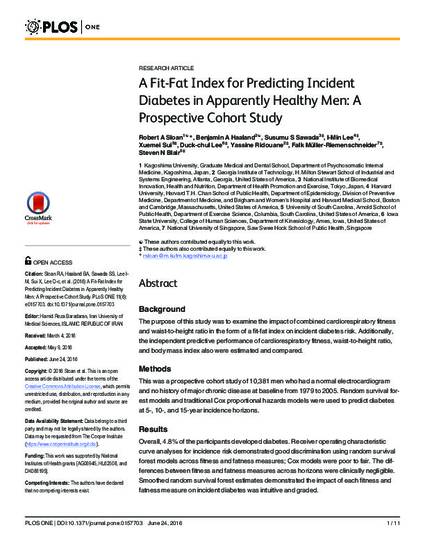
Background
The purpose of this study was to examine the impact of combined cardiorespiratory fitness and waist-to-height ratio in the form of a fit-fat index on incident diabetes risk. Additionally, the independent predictive performance of cardiorespiratory fitness, waist-to-height ratio, and body mass index also were estimated and compared. Methods
This was a prospective cohort study of 10,381 men who had a normal electrocardiogram and no history of major chronic disease at baseline from 1979 to 2005. Random survival forest models and traditional Cox proportional hazards models were used to predict diabetes at 5-, 10-, and 15-year incidence horizons. Results
Overall, 4.8% of the participants developed diabetes. Receiver operating characteristic curve analyses for incidence risk demonstrated good discrimination using random survival forest models across fitness and fatness measures; Cox models were poor to fair. The differences between fitness and fatness measures across horizons were clinically negligible. Smoothed random survival forest estimates demonstrated the impact of each fitness and fatness measure on incident diabetes was intuitive and graded. Conclusions
Although fitness and fatness measures showed a similar discriminative ability in predicting incident diabetes, unique to the study was the ability of the fit-fat index to demonstrate a better indication of incident risk when compared to fitness or fatness alone. A single index combining cardiorespiratory fitness and waist-to-height ratio may be more useful because it can indicate improvements in either or both of the measures.
Available at: http://works.bepress.com/duck-chul_lee/43/

This article is published as sloan RA, Haaland BA, Sawada SS, Lee I-Min, Sui X, Lee DC, Ridouane Y, MüllerRiemenschneider F, Blair SN. A fit-fat index for predicting incident diabetes in apparently health men: A prospective cohort study. PLOS ONE. 2016;11(6):e0157703. 10.1371/journal.pone.0157703. Posted with permission.